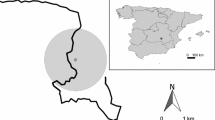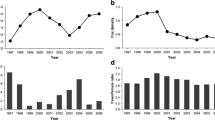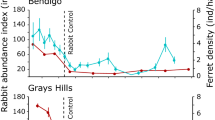Summary
Predator-prey studies in semi-arid eastern Australia demonstrated that populations of rabbits (Oryctolagus cuniculus) could be regulated by predators. The functional, numerical and total responses of foxes (Vulpes vulpes) to rabbits and the numerical response of feral cats (Felis catus) to rabbits, are described. Measurement of the rabbit component of foxes' stomach contents indicates a Type III functional response. The size of the fox population in summer was dependent on the availability of rabbits over the immediately preceding rabbit breeding season but there appeared to be no density-dependent aggregation of young foxes in areas of surplus food. The total response of foxes, estimated using the short-term numerical response of dispersing foxes, was directly density-dependent for low rabbit densities and inversely density-dependent for high rabbit densities. Two states are possible with this form of total response: a state with low rabbit densities regulated by predators and a state with high rabbit densities which occurs when rabbits escape predator regulation. The boundary between regulation and non-regulation by predators was demonstrated by a predator-removal experiment. In the treated areas, predators were initially culled and rabbits increased to higher densities than in an untreated area where predators were always present. When predators were allowed back into the treated areas, rabbit populations continued to increase and did not decline to the density in the untreated area. This is the critical evidence for a two-state system. When predators were present, rabbits could be maintained at low densities which were in the density-dependent part of the total response curve for foxes. Exceptionally high rabbit recruitment, or artificially reduced predation, could result in rabbits escaping predator-regulation. Under these circumstances, rabbits could move into the inversely density-dependent region of the total response curve for foxes.
Similar content being viewed by others
References
Catling PC (1988) Similarities and contrasts in the diets of foxes, Vulpes vulpes, and cats, Felis catus, relative to fluctuating prey populations and drought. Aust Wild Res 15: 307–317
Cooke BD (1970) Factors which influence the number of rabbits, Oryctolagus cuniculus (L.), in natural populations. M.Sc. thesis, Department of Zoology, University of Adelaide
Cooke BD (1974) Food and other resources of the wild rabbit Oryctolagus cuniculus (L.). Ph.D. thesis, Department of Zoology, University of Adelaide
Gilbert N, Myers K, Cooke BD, Dunsmore JD, Fullagar PJ, Gibb JA, King DR, Parer I, Wheeler SH, Wood DH (1987) Comparative dynamics of Australasian rabbit populations. Aust Wild Res 14: 491–503
Holling CS (1959) The components of predation as revealed by a study of small-mammal predation of the European pine sawfly. Can Entomol 91: 293–320
Holling CS (1965) The functional response of predators to prey density and its role in mimicry and population regulation. Mem Entomol Soc Can 45: 1–60
Holling CS (1973) Resilience and stability of ecological systems. Annu Rev Ecol Syst 4: 1–23
Jones E, Coman BJ (1982a) Ecology of the feral cat, Felis catus (L.), in south-eastern Australia. II. Reproduction. Aust Wild Res 9: 111–119
Jones E, Coman BJ (1982b) Ecology of the feral cat, Felis catus (L.), in south-eastern Australia. III. Home ranges and population ecology in semiarid north-west Victoria. Aust Wild Res 9: 409–420
Kruuk H (1972) Surplus killing by carnivores. J Zool Lond 166: 233–244
Lindstrom E (1989) Food limitation and social regulation in a red fox population. Holarct Ecol 12: 70–79
Lloyd HG (1980) The red fox. Batsford, London
Macdonald DW (1976) Food caching by red foxes and some other carnivores. Z Tierpsychol 42: 170–185
Macdonald DW (1983) The ecology of carnivore social behaviour. Nature 301: 379–384
May RM (1981) Models for two interacting populations. In: May RM (ed), Theoretical Ecology, Principles and Applications, 2nd edn. Blackwell Scientific Publications, UK, pp 78–104
Murdoch WW, Oaten A (1975) Predation and population stability. Adv Ecol Res 9: 1–131
Newsome AE, Parer I, Catling PC (1989) Prolonged prey suppression by carnivores-predator-removal experiments. Oecologia 78: 458–467
Parer I (1977) The population ecology of the wild rabbit, Oryctolagus cuniculus (L.), in a Mediterranean-type climate in New South Wales. Aust Wild Res 4: 171–205
Parer I (1982) European rabbit (Australia). In: Davis DE (ed), CRC Handbook of Census methods for Terrestrial Vertebrates, CRC Press, Florida, pp. 136–138
Parer I, Libke J (1985) Distribution of rabbit, Oryctolagus cuniculus, warrens in relation to soil type. Aust Wild Res 12: 387–405
Parer I, Wood DH (1986) Further observations of the use of warren entrances as an index of the number of rabbits, Oryctolagus cuniculus. Aust Wild Res 13: 331–332
Ricklefs RE (1979) Ecology, 2nd edn. Chiron Press, New York
Ridpath MG, Brooker G (1986) The breeding of the wedge-tailed eagle Auila audax in relation to its food supply in arid Western Australia. Ibis 128: 177–194
Robbins CT (1983) Wildlife feeding and nutrition. Academic Press, New York
Robertson G (1987) Effect of drought on a breeding population of wedge-tailed eagles Aquila audax. Emu 87: 220–223
Rosenstein L, Berman E (1973) Postnatal bodyweight changes of domestic cats maintained in an outdoor colony. Am J Vet Res 34: 575–577
Sargeant AB (1978) Red fox prey demands and the implications to prairie duck production. J Wildl Manag 42: 520–527
Sinclair ARE (1989) Population regulation in animals. In: Cherrett JM (ed), Ecological Concepts. (Symposium of the British Ecological Society), pp 197–241
Sinclair ARE, Olsen P, Redhead TD (1990) Can predators regulate small mammal populations?: evidence from house mouse out-breaks in Australia. Oikos 59: 382–392
Solomon ME (1949) The natural control of animal populations. J Anim Ecol 18: 1–35
Trout RC, Tittensor AM (1989) Can predators regulate wild rabbit Oryctolagus cuniculus population density in England and Wales? Mammal Rev 19: 153–173
Warner ACI (1981) Rate of passage of digesta through the gut of mammals and birds. Nutr Abstr Rev B 51: 789–820
Wood DH (1980) The demography of a rabbit population in an arid region of New South Wales Australia. J Anim Ecol 49: 55–79
Author information
Authors and Affiliations
Rights and permissions
About this article
Cite this article
Pech, R.P., Sinclair, A.R.E., Newsome, A.E. et al. Limits to predator regulation of rabbits in Australia: evidence from predator-removal experiments. Oecologia 89, 102–112 (1992). https://doi.org/10.1007/BF00319021
Received:
Accepted:
Issue Date:
DOI: https://doi.org/10.1007/BF00319021




